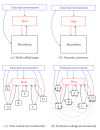Conceptualizing human microbiota: from multicelled organ to ecological community
- PMID: 19259327
- PMCID: PMC2648621
- DOI: 10.1155/2008/613979
Conceptualizing human microbiota: from multicelled organ to ecological community
Abstract
The microbiota of a typical, healthy human contains 10 times as many cells as the human body and incorporates bacteria, viruses, archea, protozoans, and fungi. This diverse microbiome (the collective genomes of the microbial symbionts that inhabit a human host) is essential for human functioning. We discuss the unstated assumptions and implications of current conceptualizations of human microbiota: (1) a single unit that interacts with the host and the external environment; a multicelled organ; (2) an assemblage of multiple taxa, but considered as a single unit in its interactions with the host; (3) an assemblage of multiple taxa, which each interacts with the host and the environment independently; and (4) a dynamic ecological community consisting of multiple taxa each potentially interacting with each other, the host, and the environment. Each conceptualization leads to different predictions, methodologies, and research strategies.
Figures


References
-
- Sekirov I, Finlay BB. Human and microbe: united we stand. Nature Medicine. 2006;12(7):736–737. - PubMed
-
- Clavell T, Haller D. Molecular interactions between bacteria, the epithelium, and the mucosal immune system in the intestinal tract: implications for chronic inflammation. Current Issues in Intestinal Microbiology. 2007;8(2):25–43. - PubMed
-
- Blaut M, Clavel T. Metabolic diversity of the intestinal microbiota: implications for health and disease. The Journal of Nutrition. 2007;137(3):751S–755S. - PubMed
-
- Fava F, Lovegrove JA, Gitau R, Jackson KG, Tuohy KM. The gut microbiota and lipid metabolism: implications for human health and coronary heart disease. Current Medicinal Chemistry. 2006;13(25):3005–3021. - PubMed
LinkOut - more resources
Full Text Sources

